child lock Acura TSX 2004 Owner's Manual
[x] Cancel search | Manufacturer: ACURA, Model Year: 2004, Model line: TSX, Model: Acura TSX 2004Pages: 364, PDF Size: 5.35 MB
Page 8 of 364
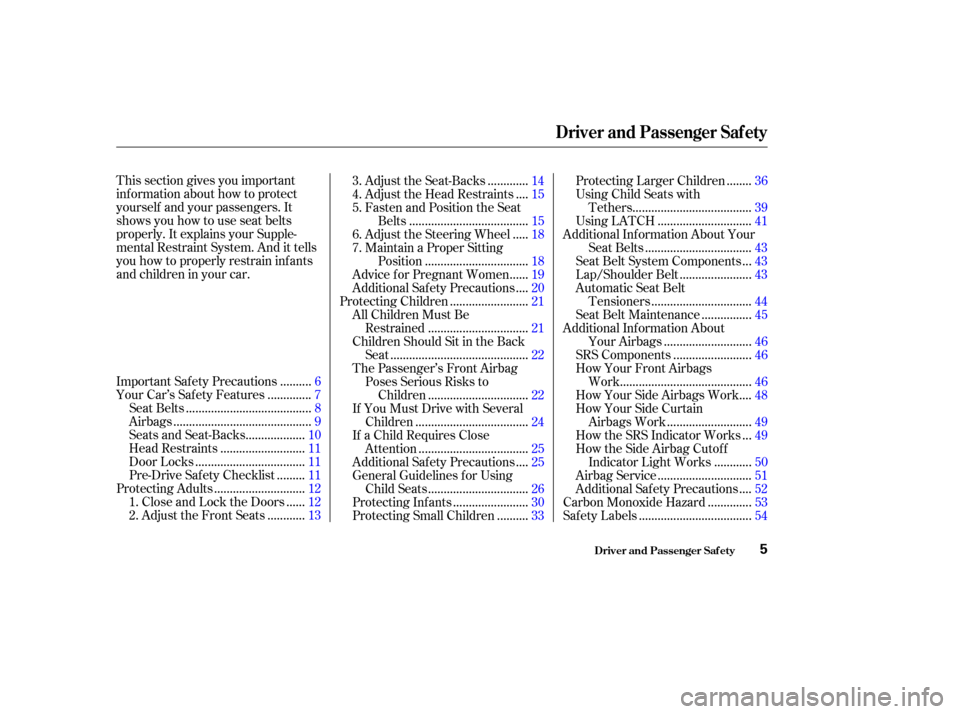
This section gives you important
inf ormation about how to protect
yourself and your passengers. It
shows you how to use seat belts
properly. It explains your Supple-
mental Restraint System. And it tells
you how to properly restrain inf ants
andchildreninyourcar..........
Important Safety Precautions . 6
.............
Your Car’s Saf ety Features . 7
.......................................
Seat Belts .8
...........................................
Airbags .9
..................
Seats and Seat-Backs . 10
..........................
Head Restraints .11
..................................
Door Locks .11
........
Pre-Drive Saf ety Checklist . 11
............................
Protecting Adults .12
.....
1. Close and Lock the Doors . 12
...........
2. Adjust the Front Seats . 13 ............
3. Adjust the Seat-Backs . 14
...
4. Adjust the Head Restraints . 15
5. Fasten and Position the Seat .....................................
Belts .15
....
6. Adjust the Steering Wheel . 18
7. Maintain a Proper Sitting ................................
Position .18
.....
Advice f or Pregnant Women . 19
...
Additional Safety Precautions . 20
........................
Protecting Children .21
All Children Must Be ...............................
Restrained .21
Children Should Sit in the Back ...........................................
Seat .22
The Passenger’s Front Airbag Poses Serious Risks to ...............................
Children .22
If You Must Drive with Several ...................................
Children .24
If a Child Requires Close ..................................
Attention .25
...
Additional Safety Precautions . 25
General Guidelines f or Using ...............................
Child Seats .26
.......................
Protecting Inf ants .30
.........
Protecting Small Children . 33 .......
Protecting Larger Children . 36
Using Child Seats with .....................................
Tethers .39
.............................
Using LATCH .41
Additional Inf ormation About Your .................................
Seat Belts .43
..
Seat Belt System Components . 43
......................
Lap/Shoulder Belt .43
Automatic Seat Belt ...............................
Tensioners .44
...............
Seat Belt Maintenance . 45
Additional Inf ormation About ...........................
Your Airbags .46
........................
SRS Components .46
How Your Front Airbags .........................................
Work .46
...
How Your Side Airbags Work . 48
How Your Side Curtain ..........................
Airbags Work .49
..
How the SRS Indicator Works . 49
How the Side Airbag Cutof f ...........
Indicator Light Works . 50
.............................
Airbag Service .51
...
Additional Safety Precautions . 52
.............
Carbon Monoxide Hazard . 53
...................................
Saf ety Labels .54
Driver and Passenger Saf ety
Driver and Passenger Saf ety
5
Page 14 of 364
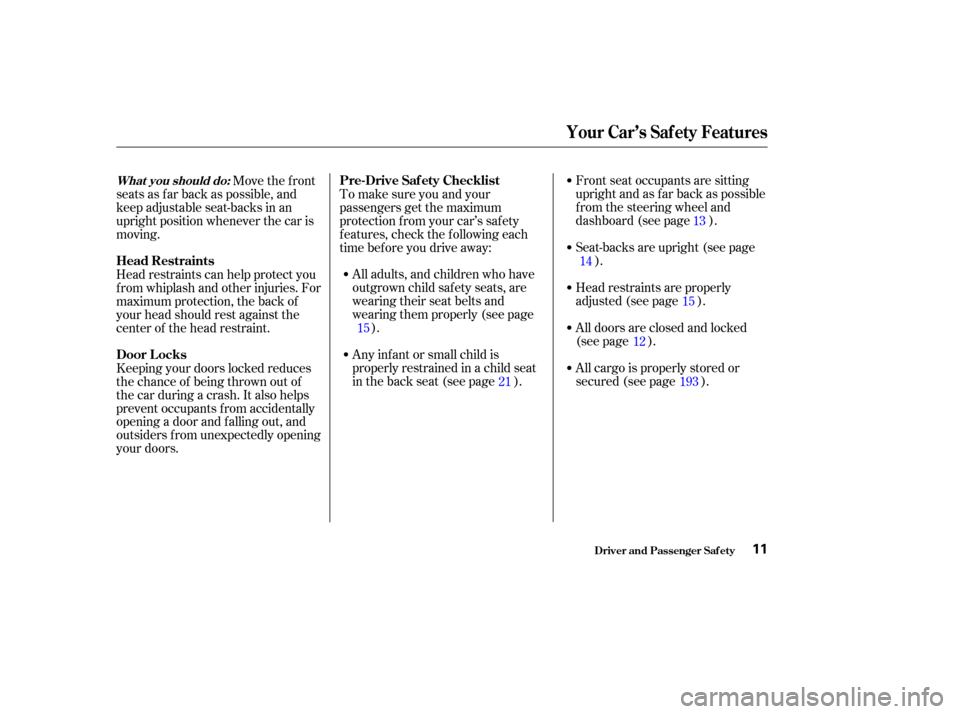
Frontseatoccupantsaresitting
upright and as f ar back as possible
f rom the steering wheel and
dashboard (see page ).
Seat-backs are upright (see page).
Head restraints are properly
adjusted (see page ).
All doors are closed and locked
(see page ).
All cargo is properly stored or
secured (see page ).
To make sure you and your
passengers get the maximum
protection f rom your car’s saf ety
f eatures, check the f ollowing each
time before you drive away:
All adults, and children who have
outgrown child saf ety seats, are
wearing their seat belts and
wearingthemproperly(seepage ).
Any inf ant or small child is
properly restrained in a child seat
inthebackseat(seepage ).
Move the f ront
seats as far back as possible, and
keep adjustable seat-backs in an
upright position whenever the car is
moving.
Head restraints can help protect you
f rom whiplash and other injuries. For
maximum protection, the back of
your head should rest against the
center of the head restraint.
Keeping your doors locked reduces
thechanceof beingthrownoutof
the car during a crash. It also helps
prevent occupants f rom accidentally
opening a door and f alling out, and
outsiders f rom unexpectedly opening
your doors. 15
14
15
12
21 13
193
Driver and Passenger Saf ety
Your Car’s Saf ety Features
Pre-Drive Saf ety Checklist
Head Restraints
Door L ocksWhat you should do:
11
Page 15 of 364
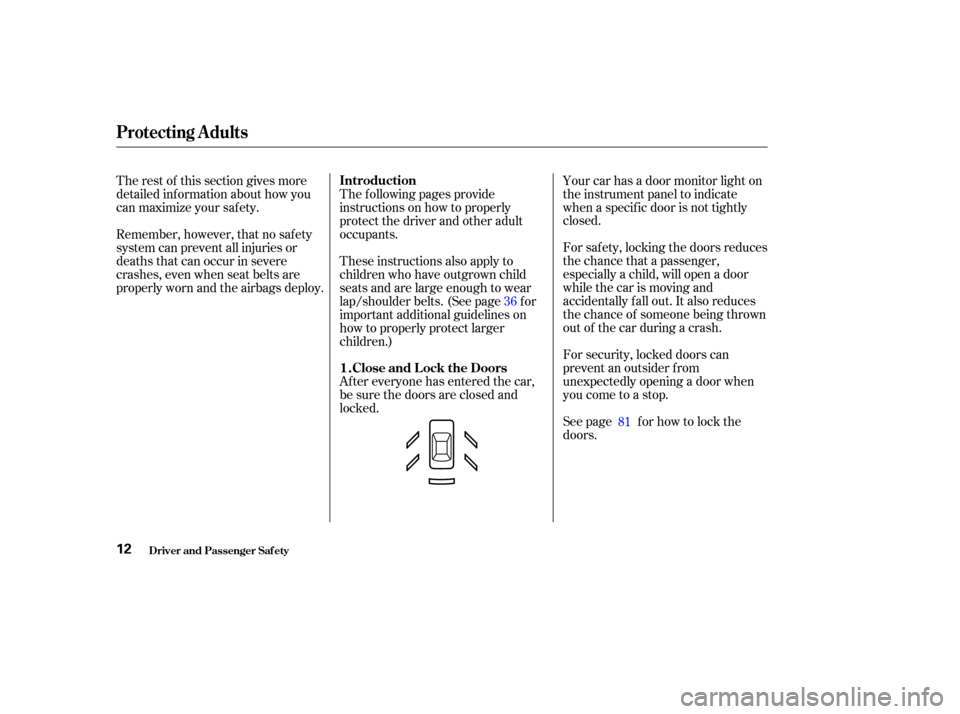
For security, locked doors can
prevent an outsider f rom
unexpectedly opening a door when
you come to a stop. Your car has a door monitor light on
the instrument panel to indicate
when a specif ic door is not tightly
closed.
For saf ety, locking the doors reduces
thechancethatapassenger,
especially a child, will open a door
while the car is moving and
accidentally f all out. It also reduces
thechanceof someonebeingthrown
out of the car during a crash.
See page f or how to lock the
doors.
Af ter everyone has entered the car,
be sure the doors are closed and
locked. These instructions also apply to
children who have outgrown child
seats and are large enough to wear
lap/shoulder belts. (See page f or
important additional guidelines on
how to properly protect larger
children.) The f ollowing pages provide
instructions on how to properly
protect the driver and other adult
occupants.
The rest of this section gives more
detailed inf ormation about how you
can maximize your saf ety.
Remember, however, that no saf ety
system can prevent all injuries or
deaths that can occur in severe
crashes, even when seat belts are
properly worn and the airbags deploy.
36
81
Driver and Passenger Saf ety
Protecting Adults
Close and L ock the Doors
Introduction
1.
12
Page 28 of 364
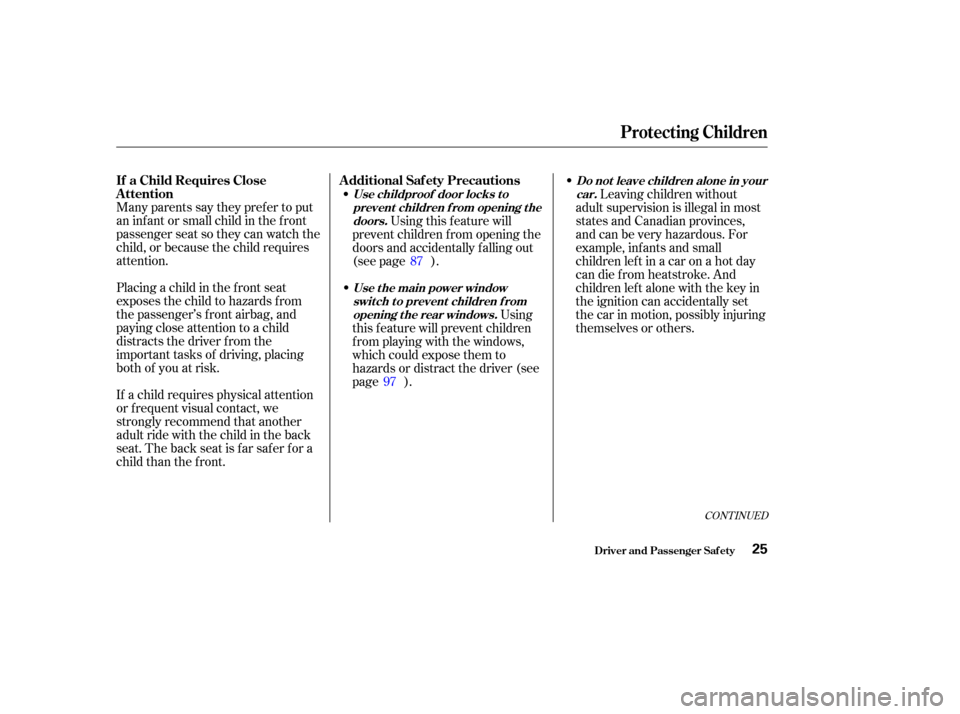
Many parents say they pref er to put
an inf ant or small child in the f ront
passenger seat so they can watch the
child, or because the child requires
attention.
Placing a child in the f ront seat
exposes the child to hazards f rom
the passenger’s f ront airbag, and
paying close attention to a child
distracts the driver f rom the
important tasks of driving, placing
both of you at risk.
If a child requires physical attention
or f requent visual contact, we
strongly recommend that another
adult ride with the child in the back
seat. The back seat is far safer for a
child than the front.Using this f eature will
prevent children f rom opening the
doors and accidentally f alling out
(see page ). Leaving children without
adult supervision is illegal in most
states and Canadian provinces,
and can be very hazardous. For
example, inf ants and small
childrenleftinacaronahotday
can die f rom heatstroke. And
children lef t alone with the key in
the ignition can accidentally set
the car in motion, possibly injuring
themselves or others.
Using
this f eature will prevent children
f rom playing with the windows,
which could expose them to
hazards or distract the driver (see
page ). 87
97
CONT INUED
Protecting Children
Driver and Passenger Saf ety
If a Child Requires Close
Attention Additional Saf ety Precautions
Use childproof door locks t o
prevent children f rom opening t hedoors. Do not leave children alone in your
car.
Use t he main power window swit ch t o prevent children f romopening t he rear windows.
25
Page 29 of 364
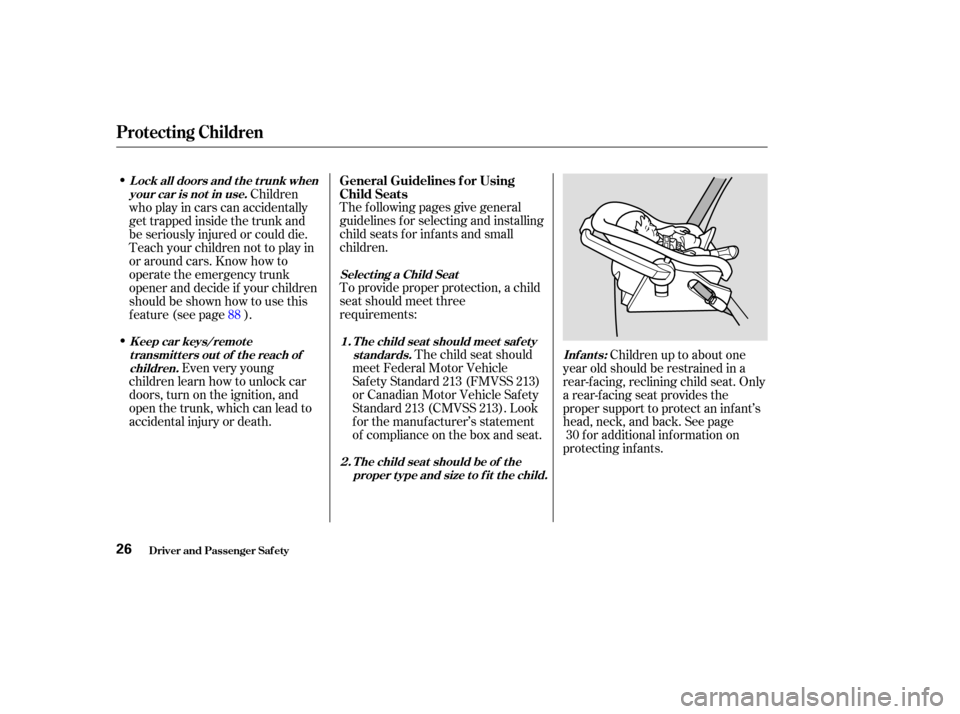
The f ollowing pages give general
guidelines f or selecting and installing
child seats f or inf ants and small
children.
To provide proper protection, a child
seat should meet three
requirements:The child seat should
meet Federal Motor Vehicle
Saf ety Standard 213 (FMVSS 213)
or Canadian Motor Vehicle Saf ety
Standard 213 (CMVSS 213). Look
for the manufacturer’s statement
of compliance on the box and seat.
Children
who play in cars can accidentally
get trapped inside the trunk and
be seriously injured or could die.
Teach your children not to play in
or around cars. Know how to
operate the emergency trunk
opener and decide if your children
should be shown how to use this
feature(seepage ).
Even very young
children learn how to unlock car
doors, turn on the ignition, and
openthetrunk,whichcanleadto
accidental injury or death. Childrenuptoaboutone
year old should be restrained in a
rear-f acing, reclining child seat. Only
a rear-f acing seat provides the
proper support to protect an inf ant’s
head, neck, and back. See page for additional information on
protecting inf ants. 30
88 General Guidelines f or Using
Child Seats
Select ing a Child Seat
T he child seat should meet saf et yst andards.
L ock all doors and t he t runk when
your car is not in use.
K eep car keys/remot etransmitters out of the reach ofchildren.
T he child seat should be of theproper t ype and size t o f it t he child. Inf ant s:
2.
1.
Protecting Children
Driver and Passenger Saf ety26
Page 34 of 364
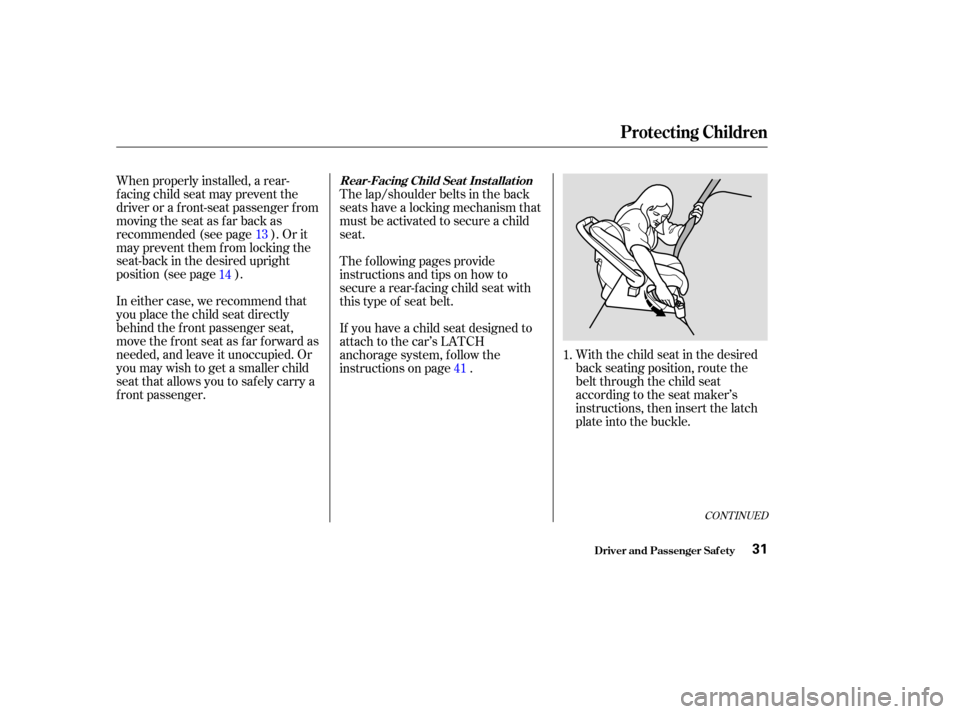
With the child seat in the desired
back seating position, route the
belt through the child seat
according to the seat maker’s
instructions, then insert the latch
plate into the buckle.
When properly installed, a rear-
f acing child seat may prevent the
driver or a f ront-seat passenger f rom
moving the seat as far back as
recommended (see page ). Or it
may prevent them f rom locking the
seat-back in the desired upright
position (see page ).
In either case, we recommend that
you place the child seat directly
behind the f ront passenger seat,
move the front seat as far forward as
needed, and leave it unoccupied. Or
you may wish to get a smaller child
seat that allows you to safely carry a
f ront passenger.
The lap/shoulder belts in the back
seats have a locking mechanism that
must be activated to secure a child
seat.
The f ollowing pages provide
instructions and tips on how to
secure a rear-f acing child seat with
this type of seat belt.
If you have a child seat designed to
attach to the car’s LATCH
anchorage system, follow the
instructions on page .
1.
13
14
41
CONT INUED
Protecting Children
Driver and Passenger Saf ety
Rear-Facing Child Seat Inst allat ion
31
Page 35 of 364
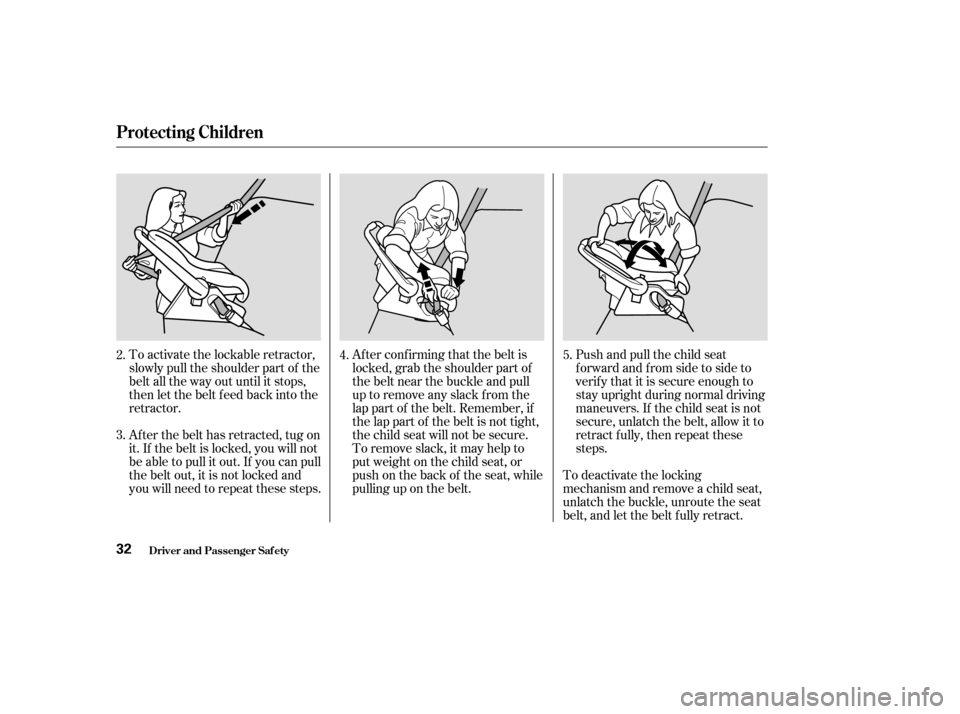
Af ter conf irming that the belt is
locked, grab the shoulder part of
the belt near the buckle and pull
up to remove any slack from the
lap part of the belt. Remember, if
the lap part of the belt is not tight,
the child seat will not be secure.
To remove slack, it may help to
putweightonthechildseat,or
push on the back of the seat, while
pulling up on the belt.Push and pull the child seat
f orward and f rom side to side to
verif y that it is secure enough to
stay upright during normal driving
maneuvers. If the child seat is not
secure, unlatch the belt, allow it to
retract f ully, then repeat these
steps.
To deactivate the locking
mechanism and remove a child seat,
unlatch the buckle, unroute the seat
belt, and let the belt f ully retract.
To activate the lockable retractor,
slowly pull the shoulder part of the
belt all the way out until it stops,
then let the belt f eed back into the
retractor.
Af ter the belt has retracted, tug on
it. If the belt is locked, you will not
be able to pull it out. If you can pull
the belt out, it is not locked and
you will need to repeat these steps.
2.
3.
4.
5.
Protecting Children
Driver and Passenger Saf ety32
Page 37 of 364
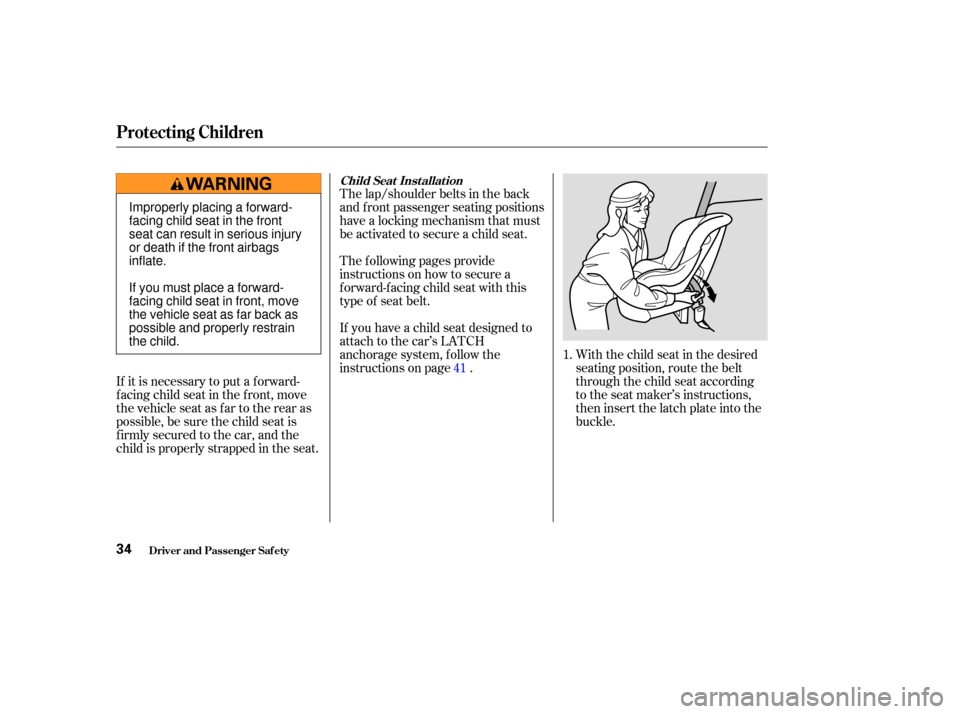
The lap/shoulder belts in the back
and f ront passenger seating positions
have a locking mechanism that must
be activated to secure a child seat.With the child seat in the desired
seating position, route the belt
through the child seat according
to the seat maker’s instructions,
then insert the latch plate into the
buckle.
The f ollowing pages provide
instructions on how to secure a
f orward-f acing child seat with this
type of seat belt.
If you have a child seat designed to
attach to the car’s LATCH
anchorage system, follow the
instructions on page .
If it is necessary to put a f orward-
f acing child seat in the f ront, move
the vehicle seat as far to the rear as
possible, be sure the child seat is
f irmly secured to the car, and the
child is properly strapped in the seat. 1.
41
Child Seat Inst allat ion
Protecting Children
Driver and Passenger Saf ety34
Improperly placing a forward-
facing child seat in the front
seat can result in serious injury
or death if the front airbags
inflate.
Ifyoumustplaceaforward-
facing child seat in front, move
the vehicle seat as far back as
possible and properly restrain
the child.
Page 38 of 364
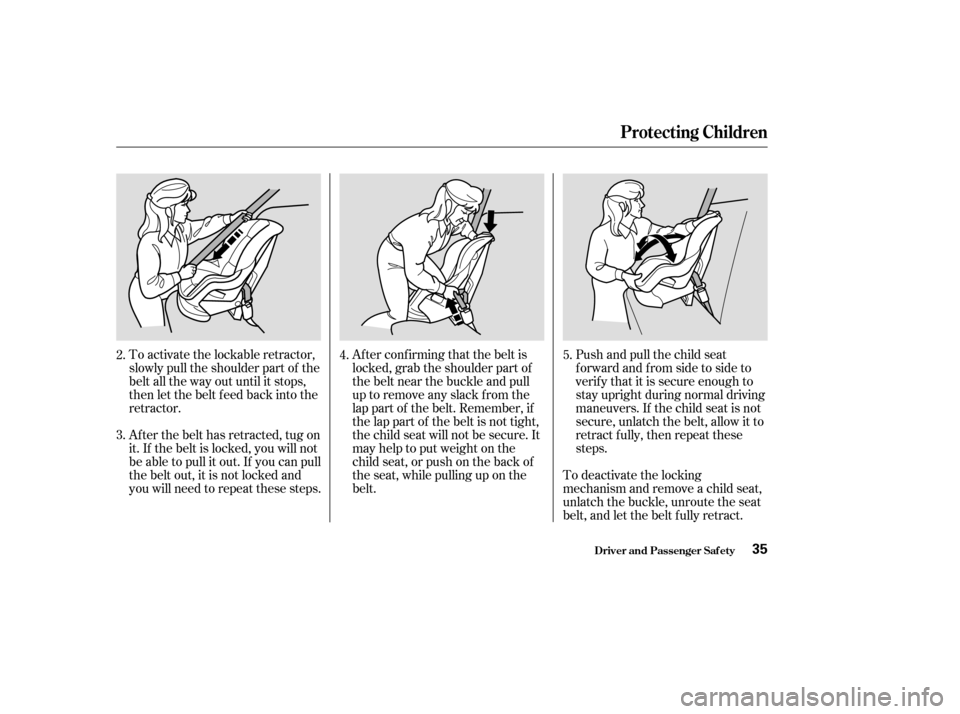
Af ter conf irming that the belt is
locked, grab the shoulder part of
the belt near the buckle and pull
up to remove any slack from the
lap part of the belt. Remember, if
the lap part of the belt is not tight,
the child seat will not be secure. It
mayhelptoputweightonthe
child seat, or push on the back of
the seat, while pulling up on the
belt.Push and pull the child seat
f orward and f rom side to side to
verif y that it is secure enough to
stay upright during normal driving
maneuvers. If the child seat is not
secure, unlatch the belt, allow it to
retract f ully, then repeat these
steps.
To deactivate the locking
mechanism and remove a child seat,
unlatch the buckle, unroute the seat
belt, and let the belt f ully retract.
To activate the lockable retractor,
slowly pull the shoulder part of the
belt all the way out until it stops,
then let the belt f eed back into the
retractor.
Af ter the belt has retracted, tug on
it. If the belt is locked, you will not
be able to pull it out. If you can pull
the belt out, it is not locked and
you will need to repeat these steps.
2.
3.
4.
5.
Protecting Children
Driver and Passenger Saf ety35
Page 46 of 364
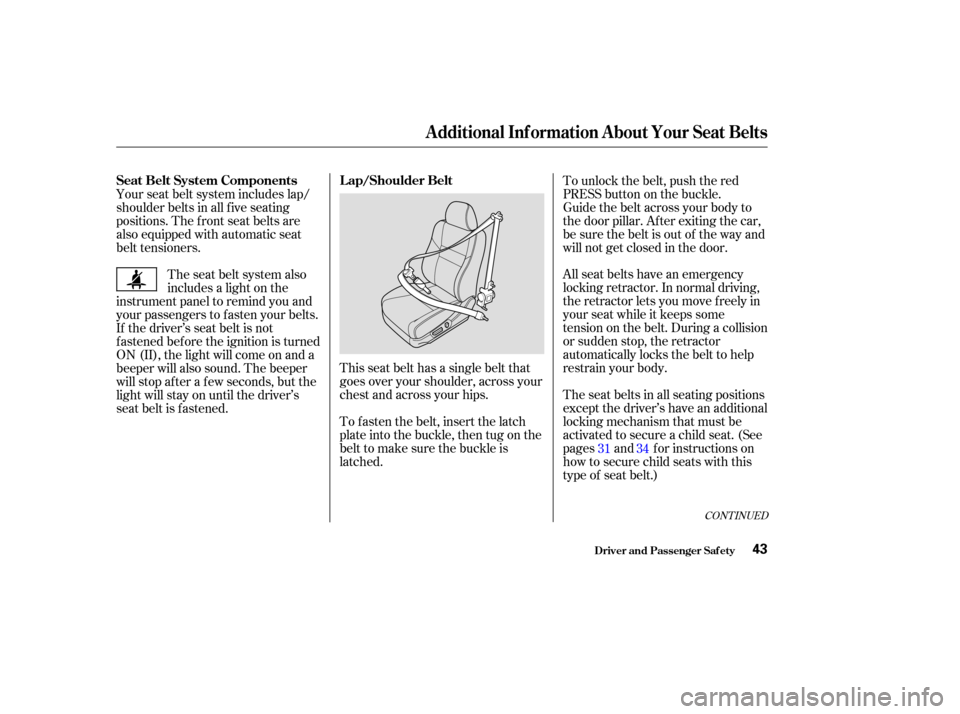
This seat belt has a single belt that
goes over your shoulder, across your
chest and across your hips.The seat belts in all seating positions
except the driver’s have an additional
locking mechanism that must be
activated to secure a child seat. (See
pages and f or instructions on
how to secure child seats with this
type of seat belt.) All seat belts have an emergency
locking retractor. In normal driving,
the retractor lets you move f reely in
your seat while it keeps some
tension on the belt. During a collision
or sudden stop, the retractor
automatically locks the belt to help
restrain your body. Guide the belt across your body to
the door pillar. Af ter exiting the car,
be sure the belt is out of the way and
will not get closed in the door. To unlock the belt, push the red
PRESSbuttononthebuckle.
To fasten the belt, insert the latch
plate into the buckle, then tug on the
belt to make sure the buckle is
latched.
Your seat belt system includes lap/
shoulder belts in all f ive seating
positions. The f ront seat belts are
also equipped with automatic seat
belt tensioners.
The seat belt system also
includes a light on the
instrument panel to remind you and
your passengers to f asten your belts.
If the driver’s seat belt is not
fastened before the ignition is turned
ON (II), the light will come on and a
beeper will also sound. The beeper
will stop af ter a f ew seconds, but the
light will stay on until the driver’s
seat belt is f astened.
31 34
CONT INUED
Seat Belt System Components L ap/Shoulder Belt
Additional Inf ormation About Your Seat Belts
Driver and Passenger Saf ety43